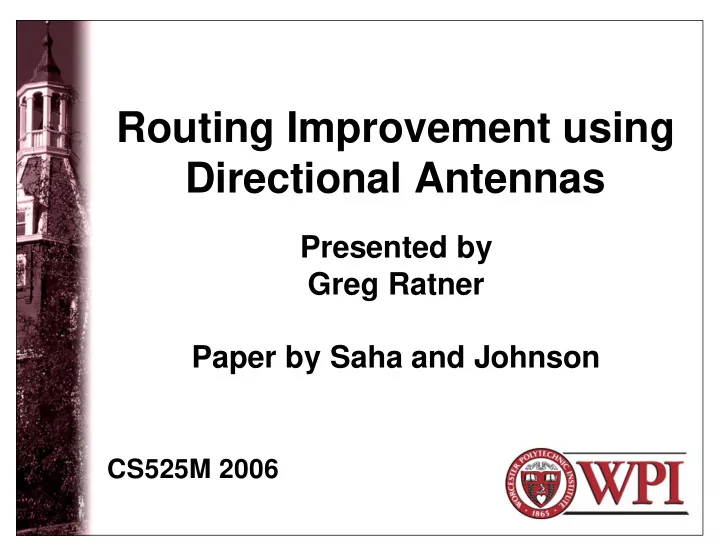

Routing Improvement using Directional Antennas Presented by Greg Ratner Paper by Saha and Johnson CS525M 2006
Overview: Directional Antennas Paper • Background • Protocol Details • Evaluation • Results • Other Application • Conclusion • Questions 2 Worcester Polytechnic Institute
Background • Primary concern: distance between mobile nodes • Directional Antennas: – Longer transmission in one direction – Less interference to other nodes Previous research devoted to network • throughput 3 Worcester Polytechnic Institute
Background cnt. • Dynamic Source Routing (DSR) – Forms a route on-demand – Uses source routing instead of relying on the routing table at each intermediate device – Source decides the entire sequence of hops to the destination 4 Worcester Polytechnic Institute
Directional Antennas • Idea: – Use of directional antennas to bridge network • Permanent partitions • Non-permanent partitions 5 Worcester Polytechnic Institute
Protocol Modification • Mobility in Ad-Hoc networks might lead to partitioning • Adaptively use directional antennas to bridge the gap 6 Worcester Polytechnic Institute
Data Structure Modification • Add 2 new flags to DSR header: – Trigger partition bridging • Handles route requests differently – Long hop • Sends packets directionally with higher power 7 Worcester Polytechnic Institute
Data Structure Modification cnt. • Each node maintains Passive Acknowledgment Table (PAT): – Target Address – When (time) inserted – List of angular ranges • Where to search for target address – List of route request package • Different sources to a single destination 8 Worcester Polytechnic Institute
Modifications to Route Discovery • Long hop – distance between 2 hops > than range of regular antenna • Source node: – Checks local route cache • If no Route Requests then send as DSR • If source already sent a Route Request, send a new request with partition bridging flag 9 Worcester Polytechnic Institute
Modifications to Route Discovery cnt. • Reciving Node: – If PAT does not have a Route Request • If partition bridging flag is not set, broadcast Route Request packet • Else – Forward Rout Request omnidirectionaly – Enter target address into PAT – Record current time in ‘When’ – Copy Route Request into a list of RR’s – Initialize directions to 240° opposite of arrival 10 Worcester Polytechnic Institute
Modifications to Route Discovery cnt. • If PAT contains an entry for Route Request – Node saves the list of Route Requests for replying – Check ‘When’ field • If < threshold list of directions is updated to exclude 60° on the direction of arrival of Route Request • If > threshold no action is necessary since one or more long hop requests were sent 11 Worcester Polytechnic Institute
Modifications to Route Discovery cnt. • If ‘When’ time in PAT expires, angular ranges are checked – For each range long hop request is sent 12 Worcester Polytechnic Institute
Modifications to Route Discovery cnt. • When Route Request arrives to its destination Route Reply is sent back • Intermediate Node that gets Route Reply does the following: – Checks PAT and creates Route Reply to all requests for the original target – Deletes the Route Request from the PAT – If there is no entry for Request packet is forwarded as DSR 13 Worcester Polytechnic Institute
Modifications to Route Maintenance • MAC layer handles long hops • If the hop is not long: – Transmit the packet omnidirectionally – If not AKed consider a long hop and try again – If still not aked or doesn’t have a direction return an error 14 Worcester Polytechnic Institute
Modifications to Route Maintenance • Signal-to-interference-and-noise- ratio (SINR) is used to unset long hop flag – If SINR > threshold of suitable signal, then unset long hop 15 Worcester Polytechnic Institute
Analysis • Evaluation • Two scenarios: – Packet delivery ratio – 90 th Percentile Packet Latency – Packet Overhead 16 Worcester Polytechnic Institute
Results • If node mobility is high protocol is less able to bridge the gap due to latency 17 Worcester Polytechnic Institute
Repairing Broken Routing • Instead of sending route errors, estimate the direction of next hop and send a directional request skipping broken link 18 Worcester Polytechnic Institute
Conclusions • Network bridging is especially effective with static end points • Big performance gain in route repair • Direction accuracy does not have a major effect 19 Worcester Polytechnic Institute
Questions • Equipment limitations? • Adjustment cost? • Stability? 20 Worcester Polytechnic Institute
References • Wikipedia – http://en.wikipedia.org/wiki/Dynamic_So urce_Routing 21 Worcester Polytechnic Institute
Recommend
More recommend